Back to Business: The State of Lower Manhattan Four Months After Hurricane Sandy
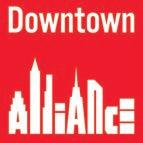

1
LOWER MANHATTAN IS BACK TO BUSINESS
Hurricane Sandy’s assault on the East Coast disrupted critical services and caused extensive property damage throughout the tri-state region, including Lower Manhattan-- the area south of Chambers Street. The impact of the storm created significant challenges for the district’s 312,000 daily workers, nearly 60,000 residents, and 1,082 storefront businesses. Most of the impact, however, was temporary. In response to the crisis a near round-the-clock effort by residents, property owners, businesses, utility companies, civic and community groups and government agencies throughout the weeks and months following the storm yielded enormous progress. While some restoration work continues today, four months after the storm there is little doubt that Lower Manhattan is back to business:
• 99% of commercial office buildings are open;i
• 99% of the residential inventory is open;
• 96% of the hotel inventory is open; and
• 90% of retailers are open.
Tenant and investor confidence in Lower Manhattan is strong:
• No commercial office tenants cancelled existing leases in Lower Manhattan following the storm;
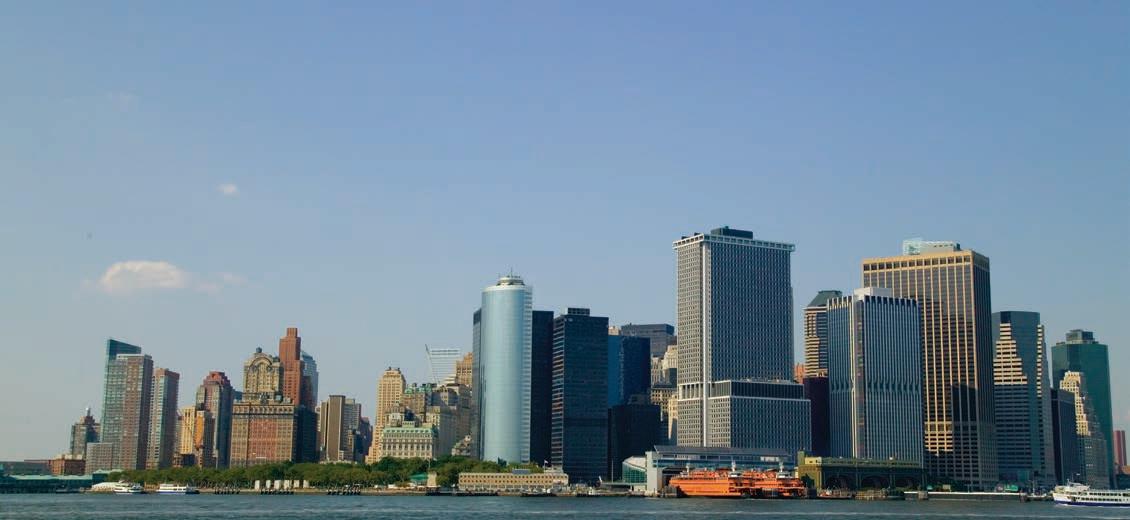
• Office leasing in Q4 2012 was up 16% over the same period in 2011, and deals signed in 2013 show momentum gaining in the market; ii
• Ten commercial office tenants currently outside Lower Manhattan signed on to move to the district;
• In the residential market, fourth quarter 2012 leasing and sales volumes were up over the same time in 2011;
• Retail market fundamentals remain strong with $5.1 billion in annual spending power, and tenants signed retail leases after the storm; and
• The hotel market showed year-over-year improvements in December’s average daily room rates and occupancy rates.
Investments in building infrastructure go beyond restoration to the pre-Sandy status quo. Forward-thinking property owners and utility companies are spending hundreds of millions of dollars in enhanced resiliency measures designed to mitigate the damage and disruption that could come from future storms, including:
• Raising critical building infrastructure above flood-prone areas;
• Hardening fuel pump rooms to better withstand flooding; and
• Verizon’s transitioning from copper to saltwater resistant fiber-optic cables, giving Lower Manhattan the nation’s most advanced telecom and data network.
Though some storm-related issues persist, the story of Lower Manhattan in the four months since Hurricane Sandy is one of challenges faced and challenges met.
2
LOWER MANHATTAN: FALL 2012
In the fall of 2012, there was positive momentum in the Lower Manhattan market with optimism about the future. The nation’s fourth-largest central business district, Lower Manhattan had 312,000 workers and an office vacancy rate of 9.3 percent. iii The economy was diversifying with momentum building as more tech and media tenants moved to Lower Manhattan. The residential population had more than doubled in ten years to nearly 60,000 people. Tourism was booming with 4,100 rooms in 18 hotels and attractions like the National September 11 Memorial & Museum drawing visitors from around the country and around the world. Retail was poised to take off with retail development in the pipeline at Brookfield Place,1 the World Trade Center, Fulton Center, and the Seaport.
IMPACT: SANDY ARRIVES IN NEW YORK CITY

Hurricane Evacuation Zones

The day before Hurricane Sandy made landfall, Mayor Bloomberg ordered a mandatory evacuation of all parts of the city in Flood Zone A and instituted a citywide construction embargo. Local and regional transportation lines, including NYC Subway, PATH service, New Jersey Transit, Long Island Railroad and Metro-North Railroad were shut down by 7 PM. Many employers advised workers not to come to work on Monday. As the storm approached on Monday, Con Edison took precautionary measures to protect infrastructure with flood barriers. In Lower
Manhattan, the utility also took power offline in the Fulton and Bowling Green electric networks, shutting off power to customers south of the Brooklyn Bridge and east of Broadway.
Hurricane Sandy hit New York City on Monday, October 29, bringing extremely high winds, rain and a massive storm surge. JFK Airport reported peak wind gusts of 79 miles per hour. The storm surge during the high tide in New York Harbor reached nearly 14 feet in Battery Park and other parts of New York City iv – surpassing the previous record-level of 10.02 feet set by Hurricane Donna in 1960 v. The surge inundated many parts of New York City, including areas both in and out of Flood Zone A. Sewers and storm drains were overwhelmed, and some buildings in Lower Manhattan and elsewhere in New York City took on millions of gallons of water.
Despite the precautionary measures, Hurricane Sandy disabled transportation systems, electricity and telecom systems. Water breached many buildings in low lying areas, causing damage and displacing people and businesses. With local and regional transportation networks severely compromised, access to Lower Manhattan as well as other parts of the city was extremely limited in the days following the storm. Damage from flooding disabled much of the city’s subway system including the South Ferry Terminal, as well as the PATH, the Holland Tunnel, and the Hugh L. Carey Tunnel. High Occupancy Vehicle restrictions were put in place on the Brooklyn Bridge, and ferry service was limited. Service was suspended on commuter rail lines in much of New York, New Jersey and Connecticut.
3
Zone A
Key Zone B Zone C
1 Previously known as the World Financial Center
Late on Monday, October 29, Con Edison’s 14th Street substation flooded when the storm reached its full intensity. With critical equipment overwhelmed by saltwater, the facility shut down, causing most of the area below 39th Street to lose electrical power for nearly five days following the storm. Many buildings did not have steam service for several more days.
The storm surge also flooded Verizon’s switching stations at 140 West Street and 104 Broad Street and inundated its back-up power and fueling systems along with most of its Lower Manhattan network infrastructure. The resulting flooding knocked out telecom and data service to virtually all customers south of Worth Street.
On November 1, the Downtown Alliance staff conducted a visual inspection of the area south of Chambers Street, observing water damage to several buildings particularly in the Seaport, along Water Street, and in the Greenwich South area. The visual survey revealed that widespread utility outages closed the majority of Lower Manhattan’s office buildings, as well as many residential buildings and tourist destinations in the days immediately following the storm.
Battery Park City Largely Unaffected

Connected to a power grid in Brooklyn, most of Battery Park City never lost power and the area suffered relatively little storm-related damage. Six million square feet at the Goldman Sachs headquarters and Brookfield Place, as well as the

Conrad New York and Ritz-Carlton, and 6,880 residential units were ready for occupancy as soon as the evacuation order was lifted on Tuesday. However, Gateway Plaza lost power and flooding damaged important neighborhood assets such as the Battery Park City ball fields. Temporary outages of back-up life safety equipment kept Tower 2 at Brookfield Place closed until the weekend.
THE ROAD TO RECOVERY
Despite the challenging conditions, great strides were made immediately to get Lower Manhattan back to business. In a strong statement of resiliency for the district and New York City overall, the New York Stock Exchange reopened on Wednesday, October 31, less than two days after the storm departed Manhattan. Property managers, residents and workers returned to Battery Park City as soon as the evacuation order was lifted on Tuesday, October 31. With the storm surge receding from local streets, property managers returned to some buildings which sustained minimal or no flood-related damage and were able to restore operations with the aid of generators. World Trade Center construction resumed Thursday, November 1. Nearby, the 9/11 Memorial Preview Site reopened Friday, November 2.
4
Immediately following the storm, the Downtown Alliance, the Association for a Better New York, the Real Estate Board of New York, the New York City Economic Development Corporation, and other city agencies including the Department of Buildings and the Department of Small Business Services, mobilized to assist business and property owners and help expedite the process of reopening properties and businesses. These organizations distributed information on recovery resources and financial assistance, identified space for temporarily displaced businesses, expedited permitting processes to speed property repairs, and aided property owners in getting pumps, generators, and other equipment. They also coordinated with utility providers, advocating for businesses and property owners.
Con Edison began restoration work on the 14th Street substation and other critical infrastructure immediately after the storm passed, and reconnected every Manhattan neighborhood to the grid by Saturday, November 3. The MTA restored many subway lines in time for the morning commute on Monday, November 5, one week after Hurricane Sandy.
RAPID RETURN OF THE OFFICE MARKET
Most of the disruption to the Lower Manhattan office market was due to the widespread loss of power, and relatively few of the district’s 351 commercial buildings sustained water damage. Buildings with access to power via generator or grids outside of Con Edison’s network were up and running just days after the storm.
Although transportation issues lingered, most commuters from throughout the New York City region could access Manhattan by Monday, November 5. Some NYC metro commuters from New Jersey, Westchester, and Long Island,
as well as New York City’s five boroughs, had to contend with alternate routes and delayed schedules, but mobility improved significantly in the second week after the storm. By Monday, November 5, subway, ferry, and regional rail lines including the
Long Island Rail Road, Metro-North, and New Jersey Transit had restored the major ity of service making it possible for both city and NYC- metro region residents to return to work.
Over the following week, the Holland Tunnel fully reopened and most of the PATH network returned on a limited weekday schedule. However, PATH riders continued to cope with crowding, delays, and alternate routes for several weeks.
The World Trade Center PATH station resumed November 26 when the Newark line was restored. Hoboken PATH riders had no service to the World Trade Center until January 30.
Four months after the storm, the only remaining transportation outage in Lower Manahttan is the South Ferry subway station, which sustained extensive damage from the hurricane.
The MTA is considering two interim solutions to return service while the station undergoes repairs. One is to temporarily restore service to the old South Ferry loop while the newer station is rebuilt, and the other option is to run service into the new station during reconstruction. The PATH train resumed weekend service on March 1.
5
PATH Station Battery Park City M 9 9 20 20 N = = = = = = = = = = M = = = = = = = = = E = 103 M 103 103 103 15 M 15 9 M 9 9 9 9 9 M 22 22 22 15 15 M 15 15 51 51 51 51 51 51 15 M 15 M 22 22 25 25 25 X 90 90 25 25 25 X 25 25 90 90 90 M 15 M 15 6 20 M 20 M 20 20 M 6 22 22 M 20 20 20 90 M 22 M 22 22 E 15 6 1 M 1 M 1 M 1 1 M 6 X 25 X 90 Bowling Green 2 Wall St Wall St Broad St Fulton St Fulton StBroadway Nassau St Brooklyn Bridge City Hall Franklin Street 1 South Ferry Rector St Park Place Chambers St Canal Street Canal Street Canal Street Fulton St Pier11 Chambers Street Chambers Street R Rector St City Hall Whitehall Street South Ferry Staten Island Ferry Terminal Ferries to/from: • Port Imperial (Weehawken) • Hoboken • Jersey City (Colgate) • Liberty State Park • Belford • NY Water Taxi (various stops) Ferries to/from: • Port Imperial (Weehawken) • Hoboken • Liberty Harbor • Port Liberté • Atlantic Highlands (Seastreak) • Highlands (Seastreak) • NY Water Taxi (various stops) Ferry to/from: • Staten Island (St. George) • Governor’s Island Ferry to/from: • Statue of Liberty/ Ellis Island Pier17 C A 4 5 M J Z 2 3 2 34 W R 5 4 5 M 2 3 2 3 1 C A 1 1 2 3 M J Z 4 5 6 C A C W R M A C W R QN B D 1 4 5 Chinatown Ferry to/from: Cortlandt St Seaport Financial District
TriBeCa
Battery Park City Greenwich South World Trade Center World Financial Center Challenge: Getting Back to Business with a Disabled Regional Transit Network
Overcoming Disruptions to Telecom and Data Service
Another factor affecting the timeline for returning office tenants to Lower Manhattan was the ability of telecom providers to restore service to the district’s voice and data networks. Some tenants with service from Time Warner Cable, Cogent, Lightpath and other providers had few disruptions or were back in service quickly.
Many others, including most of Verizon’s Lower Manhattan customers, faced delays in getting service back.
According to Verizon, the first step to restoring service was the rebooting of its two flooded switching stations in Lower Manhattan. Following 9/11, Verizon upgraded the 140 West Street location by installing switch gear on an upper floor which allowed for an emergency power supply. After Sandy the utility relied on this back-up power supply to fully reenergize that station and swiftly restore service to fiber optic customers on the west side of Lower Manhattan.
Restoring power to the Broad Street switching station, where back-up power connections were low lying, was slower.
This restoration, completed by November 10, returned service to fiber optic customers on the East side of Lower Manhattan. Others in flooded properties did not get service back until repairs were made to damaged telecom and data equipment located within individual buildings.
Massive saltwater infiltration irreparably damaged Verizon’s copper-based network throughout the flood zone. As they began the lengthy process of replacing all copper lines with new fiber optic cables, Verizon deployed interim communication solutions, including wireless service and free call forwarding to residential and small business customers.
Originally, the timeframe for achieving full service restoration was given as May 2013 – but working closely with the Mayor’s office and Lower Manhattan property owners, Verizon was able to accelerate that timeframe considerably. By December 19, 2012, rapid progress on fiber optic installation allowed Verizon to restore service to 70% of the affected office buildings.vii Meanwhile, other service providers, notably Time Warner Cable, stepped up their efforts to service customers, bringing many more Lower Manhattan tenants back online within weeks of the storm.
Getting Back to Business While Waiting for Power
Efforts by property owners to provide temporary power in conjunction with Con Edison’s work to restore permanent connections damaged by floodwater helped tenants return to their buildings. Generators were crucial to this effort. They allowed landlords to provide power to tenants, make time-consuming and expensive investments to move critical infrastructure above flood prone areas. Four months after the storm, twelve Lower Manhattan buildings are running on back-up generators. Another three buildings have generators on stand-by. These generators are no longer a sign of disarray, but rather a sign of investment for the future.
The repair of Con Edison’s 14th Street substation on Saturday November 3 reintroduced power to the full grid south of 39th Street. By Monday November 5, approximately 65 percent of office stock was open to tenants. With many subways, bus routes and, crucially, Hudson River ferry service, back in operation, much of Lower Manhattan’s workforce returned to work within one week of the storm.
At this one-week mark, it was clear that the great majority of Lower Manhattan was back to business, with office tenants resuming normal operations, stores and restaurants selling goods, and most residents back home. Some parts of the district, however, had sustained more significant damage.
With power restored, property owners could fully assess buildings. The extent of damage was evident with 35 percent of Lower Manhattan’s office stock closed for more than a week.
These closures were concentrated along the East River, including the Seaport, as well as the east side of West Street.
Many Challenges to Getting Back to Business
Even as many office buildings resumed operations quickly, other factors such as severe water damage, regional transportation disruptions and utility outages complicated the return of many Lower Manhattan office buildings and their tenants.
For properties with extensive flood damage, the recovery process was challenging and complex. Many buildings needed to replace equipment within large, multifaceted building systems and repairs were delayed as vendors sourced parts. In addition, extensive damage to many buildings’ internal electrical systems prevented the immediate and permanent restoration of power. Two hundred fifty-six of Con Edison’s vi

6
Fried Frank Weathers the Storm
Storm damage caused the temporary closure of One New York Plaza, displacing Fried, Frank, Harris, Shriver & Jacobson and its 350 New York lawyers. As an interim solution, the firm leased short term space in Midtown for about 40% of their lawyers. Another 10% worked from other offices and the remainder worked remotely. Fried Frank considered taking additional space in anticipation of longer displacement, but the quick recovery of One New York Plaza and restoration of fiber-based telecom and data service allowed them to get back into the build ing less than one month after the storm, within the time frame originally estimated by their landlord, Brookfield. The firm was back to business in Lower Manhattan by November 27, 2012.
major Manhattan customers were without power, 60 percent of whom (158) were located on or below Chambers Street.
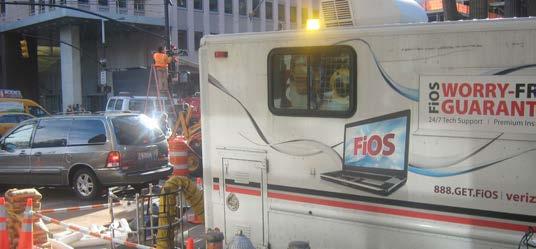
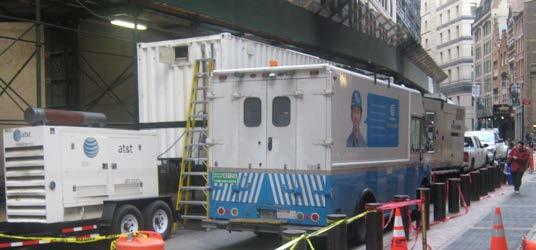
Generators began arriving en masse to the district, allowing many office tenants to return to work even as property owners and utilities worked diligently on permanent service restoration. In mid-December, 35 buildings used generators and external boilers, giving the superficial impression of a district in crisis. The widespread presence of this equipment, however, ultimately allowed office tenants to return and resume normal business operations quickly. The return of workers was not just important to the office economy, but was critical for Lower Manhattan retailers, who desperately needed the patronage of local workers, especially as holiday shopping season approached.
In the weeks following the storm, property owners worked tirelessly to bring closed buildings back online: replacing damaged floors and walls; drying out air ducts with massive fans; repairing electrical equipment and switch gear; and restoring life safety systems. The restoration of closed office buildings followed at a rapid clip – 80 percent by week 3, 89 percent by week 7, and 96 percent by week 9, or year end.
Dramatic Recovery of the Office Market Four Months Post-Sandy
With floodwaters pumped out, utilities fortified and the vast majority of the transportation infrastructure back on track – almost all of Lower Manhattan’s large office tenants
Percent of Commercial Office Inventory Open (square feet)
are back to business. While there are isolated cases of pro longed displacement of tenants, such as JP Morgan Chase and the Daily News at 4 New York Plaza, most of those dislocated at year end 2012 have returned. This includes Standard & Poor’s, which is now reoccupying its 1.06 million square feet leased at the hard-hit 55 Water Street. To date 99% of the Lower Manhat tan inventory is back online.
Con Edison has made tremendous progress on permanent utility restoration. As of late February, approximately 95 percent of ma jor customers who were without power on November 3 had their power back. viii By that same date, Verizon restored service to 95 percent of office buildings. iv Other telecom service providers such as Time Warner Cable have made major investments to expand within Lower Manhattan.
7
Source: Jones Lang La Salle
Top Ten Commercial Office Leases Signed Since Hurricane Sandy
Tenant Name Building AddressSF LeasedTransaction Type Industry
New York State Department of Financial Services1 State Street Plaza237,991 Expansion/Lease/RenewalGovernment
Creative Services, Media Transatlantic Reinsurance Company
HarperCollins Publishers 195 Broadway 179,436 Relocation
Liberty Plaza 130,268 Direct FIRE
Liberty Mutual 55 Water Street 130,000 Renewal and ExpansionFIRE AECOM 125 Broad Stree t 91,414 Dir ect
Creative Services, Other American Arbitration Association 120 Broadway 75,000 Direct Professional Services, Law D'Amato & Lynch, LLP
Professional Services, Law Regus
World Financial Center57,999 Renewal
World Financial Center54,991 Move In FIRE Institute for Community Living 125 Broad Street 41,594 Direct Healthcare Census Bureau 32 Old Slip 39,406 Reloca tion Government
Source: CBRE, CoStar, Downtown Alliance
The effects of the storm did not deter tenants looking to lease office space in Lower Manhattan. Leases including AECOM’s deal for 91,400 square feet at 125 Broad Street and Interactive Data Corporation’s 67,000-square-foot renewal at 100 Williams Street contributed over 1.23 million square feet of office transactions in Q4 2012 – roughly on par with the prior quarter, and 16 percent more than Q4 2011. Nearly all pending transactions before Hurricane Sandy continued in the a following, and brokers report that few if any special concessions were required to close deals already in progress, including leases in buildings that had been affected by the storm. No existing tenants cancelled leases after the storm, and ten tenants currently outside Lower Manhattan, such as online media firm Refinery 29 and HarperCollins Publishers, signed on to relocate to the district.
Percent Of Residential Inventory Open (Units)
Source: Downtown Alliance
RESIDENTIAL MARKET RECOVERS QUICKLY AFTER THE STORM
Hurricane Sandy caused significant disruptions for Lower Manhattan’s residents. As elsewhere in the region, many residences south of Chambers Street were without power and heat for the first days following the storm. They also had to deal with disruptions to transit and telecom networks as well as the temporary closure of schools and other community institutions.
Those residents living in the minority of Lower Manhattan buildings that took on floodwater faced greater challenges. One week after the storm, residents in some 42 buildings with 5,950 units – about 20 percent of the district’s inventory — were temporarily displaced. Most of these units were in Flood Zone A, concentrated in the Seaport, on Water Street, and in the Greenwich South area. Though these temporary challenges upended life and routine for many, Lower Manhattan residents were thankfully spared the loss of life and widespread property damage inflicted elsewhere in the region.
8
1
2
3
Lower Manhattan Office Leasing by Quarter 0 200,000 400,000 600,000 800,000 1,000,000 1,200,000 1,400,000 Q4 2011Q1 2012Q2 2012Q3 2012Q4 2012 Source: CBRE
Much like the office inventory, most of the flooded residential properties recovered quickly. Within three weeks, 3,400 units were back online, allowing displaced residents to return. Still, some 13 percent of the inventory remained closed.
Over the following weeks, progress to restore the residential building stock continued. By year end 2012, 4,914 of the original 5,950 once-closed units were back online – increasing the share of open units among the total residential inventory of the district to 97 percent. Efforts to repair damage to 2 Gold Street and adjacent property 203 Pearl Street, which accounted for much of the 3% of units still closed, accelerated into the new year, and the building reopened ahead of schedule in mid-February.
Residential Market Four Months Post-Sandy

Four months after the storm, 99 percent of Lower Manhattan’s residential units are back online. Through the recovery process, residents remained committed to living in Lower Manhattan. Data from Q4 2012 shows a tight rental market with vacancy at just 1.21 percent, down slightly from 1.37 percent in the fourth quarter of last year. xi Pricing also increased in the fourth quarter, with average rent up 7 percent over the previous quarter to $4,273, maintaining a consistent 10 percent premium over the city-wide average rent. The market for owneroccupied units also remained strong post-storm, with a 10 percent increase in the volume of sales in Q4 2012 compared to Q4 2011. xii
RECOVERY IN THE HOSPITALITY MARKET AND TOURISM
Percent of Hotel Inventory Open (rooms)
Lower Manhattan’s tourist attractions and hotel properties experienced significant storm-related damage and closures. And, like the office and residential markets, much of the tourism and hospitality sector recovered quickly, though the road to recovery has been longer for some.
One week after the storm, 36 percent of Lower Manhattan’s hotel inventory, a total of 1,473 hotel rooms in eight hotels, was closed. However, by the end of November, five hotels had re opened, bringing a full 94 percent of the inventory (some 3,855 hotel rooms) back on line. By the end of the year, 97 percent of inventory was open, and just two small hotels remained closed, both just south of the Seaport.
9
Average Residential Rent in Lower Manhattan $3,000 $3,200 $3,400 $3,600 $3,800 $4,000 $4,200 $4,400 Q4 Q1 Q2 Q3 Q4 2011 2012 Lower ManhattanSource: Miller Samuel/Prudential Douglas Elliman Volume of Residential Sales in Lower Manhattan 80 90 100 110 120 130 140 150 160 Q4Q1Q2Q3Q4 2011 2012 Lower Manhattan Source: Miller Samuel/Prudential Douglas Elliman
Source: Downtown Alliance
While nearly all of Lower Manhattan’s main tourist attractions closed when the storm surge inundated New York Harbor, 21 of the district’s 38 museums and attractions reopened within one week – notably the 9/11 Memorial, which reopened to visitors. on November 6. The storm damaged several sites, including the Statute of Liberty, Ellis Island and much of the South Street Seaport shopping area and the Seaport Museum, all remaining closed for weeks. By the end of February, another eleven attractions reopened, though the repairs to the remaining six sites are still ongoing. Though these prolonged closures caused a 22 percent drop in tourist traffic in the fourth quarter of 2012, the quick recovery of most of the Lower Manhattan tourist market helped close out the year with a record 11.5 million visitors.xiii
Tourism and Hospitality Four Months Post-Sandy
The status of tourism in Lower Manhattan four months after the storm is a mixed picture. While today, 32 of Lower Manhattan’s total 38 tourist venues are back in operation, a small but impor tant collection of Lower Manhattan’s attractions remain closed. These include the New York City Police Museum, as well as marquee attractions such as Ellis Island and the Statue of Liberty, which the National Parks Service expects will reopen by mid to late summer, respectively. Additionally, significant parts of the South Street Seaport remain shuttered. The pro longed closure of major attractions will inhibit Lower Manhattan tourism traffic counts in 2013.
Despite the setback in tourist traffic, however, the hotel market performed well in Lower Manhattan through 2012. The recovery of many office buildings and hotel properties during the strong holiday season propelled the Lower Manhattan hotel market forward by year end. The hotel market had year-over-year improvements in both the average daily room rate, up 8 percent to $305.12 at year-end 2012, and occupancy, which increased three percentage points to reach 83 percent in December 2012.xiv
SLOW BUT STEADY RECOVERY OF THE RETAIL MARKET
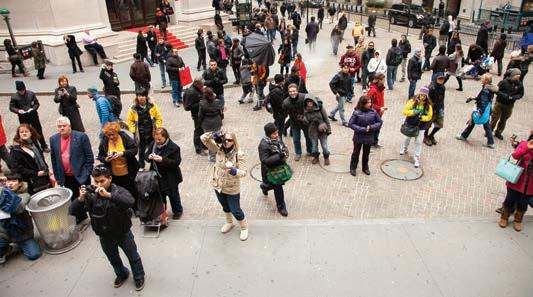
Percent of Retail Open (number of establishments)
The district’s 1,082 shops, restaurants and storefront services perhaps felt the impact of Hurricane Sandy most acutely. Some 30 percent of businesses were closed for more than a week. Utility outages and transit disruptions also created unique challenges for small businesses that suffered a reduction in customers as the other segments of the Lower Manhattan economy got back to business. Many shopkeepers and storefront services in Lower Manhattan experienced a loss of operating revenue in the days following the storm, as evacuation orders, widespread building closures and transit disruptions kept customers away. Some also lost perishable inventory as power remained off for several days. For most Lower Manhattan storefront businesses, however, the reopening of buildings, reenergizing of the power grid, restoration of most transit service and the return of residents and workers brought the bulk of their business back to the district.
Storefronts that suffered flooding damage or prolonged power outages faced greater challenges opening their doors. All 111 shops, restaurants and service providers in the Seaport closed. 320 storefront businesses in Lower Manhattan were closed for a week or more. Just two weeks later, however, 50 of those 320 closed stores had reopened. By the end of December, a total 87 percent of retailers were open south of Chambers Street. While 44 stores at Pier 17 in the hard-hit Seaport area in time reopened for peak holiday season tourism and shopping, that area continues to wrestle with the dual challenges of decreased foot traffic and ongoing restoration work.
Source: Downtown Alliance
The Downtown Alliance Launches the Back to Business Grant Program –
was in the form of loans, and while these were tremendously helpful to some, many small business owners were hard-pressed to take on more debt.
The Downtown Alliance stepped in quickly to fill urgent need among Lower Man hattan’s small business community by creating the Back to Business Grant Pro gram– the first and largest grant program available post-Sandy.
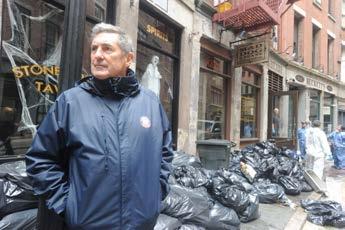
Costs of capital repairs and inventory replacement, a reduction in business, and the lack of sufficient insurance among Lower Manhattan’s small business community created intense financial pressure and fear of closure. Most of the available small business assistance
Retail Challenge: Doing Business Under Difficult Circumstances

The program offered up to $20,000 to qualifying small businesses in Flood Zone A below Chambers Street, with funds disbursed upon reopening. Completed applications were processed on a first-come, first-served appointment basis, and grants were disbursed by ACH transfer so businesses would receive the funds the day after they were approved.
The program was announced on November 19, just three weeks after the storm. The Downtown Alliance contributed the first $1 million and marshalled additional funds amounting to nearly $600,000. The Downtown Alliance made applications available on November 30, and the first round of grants was awarded on December 18. The Alliance disbursed $266,300 to 17 businesses and another $120,000 in deferred grants was made to 6 businesses that had not yet reopened. The Downtown Alliance had allocated all grant funds by February 19. As of the release of this report, the Downtown Alliance disbursed $1,217,965 in grant funds to 85 small businesses, and $370,949 in deferred awards to 20 small businesses that will receive funds upon reopening.)
Though most residents and workers came back to Lower Manhattan within a week of the storm, and tourists returned to reopened sites and attractions, the prolonged displacement of a share of retail customers created lasting challenges for many stores, restaurants and service providers. Average weekday transit ridership on Lower Manhattan subways, ferries and the PATH dropped by 50,500 riders, or 12 percent, in Q4 2012. x xv
Decreased foot traffic near transit stops and around empty buildings took a toll on some businesses, an especially hard blow during the critical holiday shopping season.
Widespread and prolonged data and telecom outages inhibited some 220 businesses from swiping credit cards and taking orders via phone, fax and over the internet. Difficulties in reestablishing power required many businesses to scramble to find generators, a costly but necessary workaround to get back to businesses.
Assistance for Retailers: A Community Comes Together
Many organizations stepped up to assist those hit hard by the storm, and the Downtown Alliance worked closely with FEMA and the US Small Business Administration, the New York City Department of Small Business Services and Community Board 1 to assist local businesses in gaining access to valuable city, state and federal recovery loans, legal assistance and insurance services.
In addition, the Downtown Alliance launched three initiatives designed to help retailers’ businesses recover. The first initiative was a revamped and expanded holiday marketing campaign, which included out-ofhome, print, web and direct mail advertising to encourage local residents and workers to shop in Lower Manhattan for the holidays.
The Downtown Alliance launched a second initiative in partner ship with Square, a company that provides mobile credit card readers that work with handheld mobile technologies such as iPhone, iPad or Android devices. The Downtown Alliance distributed 100 free readers to local restaurants, stores, and storefront service providers, enabling businesses without reliable telecom, fax and data service to accept pay ments, track sales, and manage their business. The Downtown Alliance’s third and most extensive effort was “Back to Busi ness”, a $1.59 million grant program that offered up to $20,000 to qualifying small businesses in Flood Zone A below Chambers Street. The program, launched quickly with generous financial support from many local donors, awarded much-needed grant money to 105 Lower Manhattan retailers.

11
Retail Market Four Months Post-Sandy
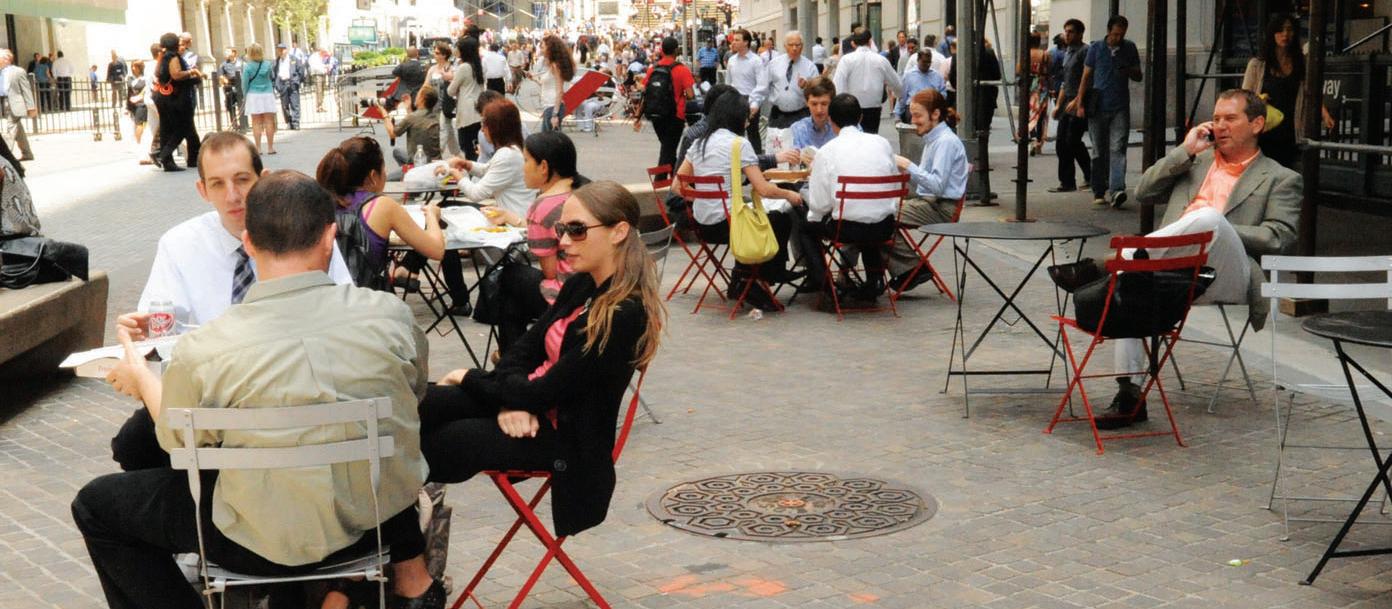
As a result of lost inventory, extensive property damage and diminished foot traffic, the retail sector has been the slowest to fully recover from the storm. Of the 320 establishments that were closed longer than a week, 209 have reopened again. Four months later many businesses remain closed, some permanently. Additionally, there are 94 Lower Manhattan retail and storefront businesses, approximately 10percent of all those open today, operating without full data or telecom service, and some with no service at all. Despite these challenges, a huge variety of 971 of the district’s 1,082 retailers are open. Each week yields more foot traffic, as office tenants and residents return to the district.
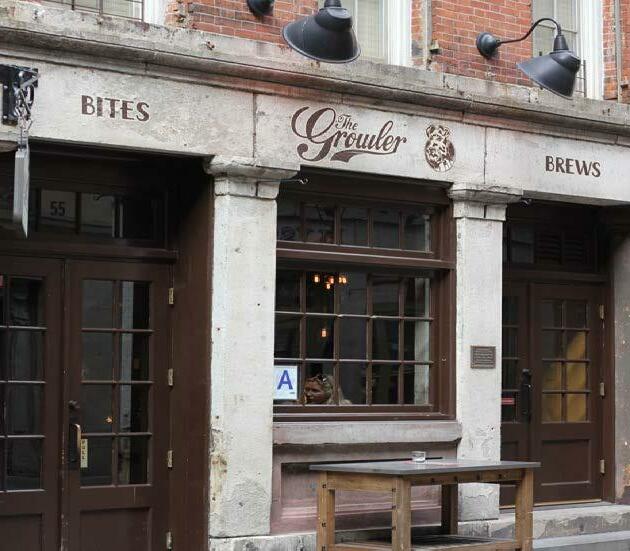
The prospects for long-term recovery – and expansion –of the Lower Manhattan retail market remain extremely positive. Brokers report that deal-making continued after Sandy, including tenants like TD Ameritrade at 100 Broadway, a gourmet market at 2 William Street, and the UFC Gym at 80 John Street. Nearly 312,000 workers xvi, 60,000 residents, and 11.5 million annual touristsxvii yield nearly $5.1 billion in annual spending power, much of which is currently untapped by the local market.
Hundreds of millions of dollars are being spent today to capitalize on that market, and by 2015 there will be 815,000 square feet of retail, restaurant, and entertainment space at Westfield World Trade Center, Brookfield Place in Battery Park City, the MTA’s Fulton Center, and Howard Hughes’ South Street Seaport along the East River.
12
Current Retail Market Fundementals 311,900 workers 60,000 residents 11.5 million annual visitors $5.1 billion in annual spending power
IN CONCLUSION: TOWARDS A MORE RESILIENT LOWER MANHATTAN
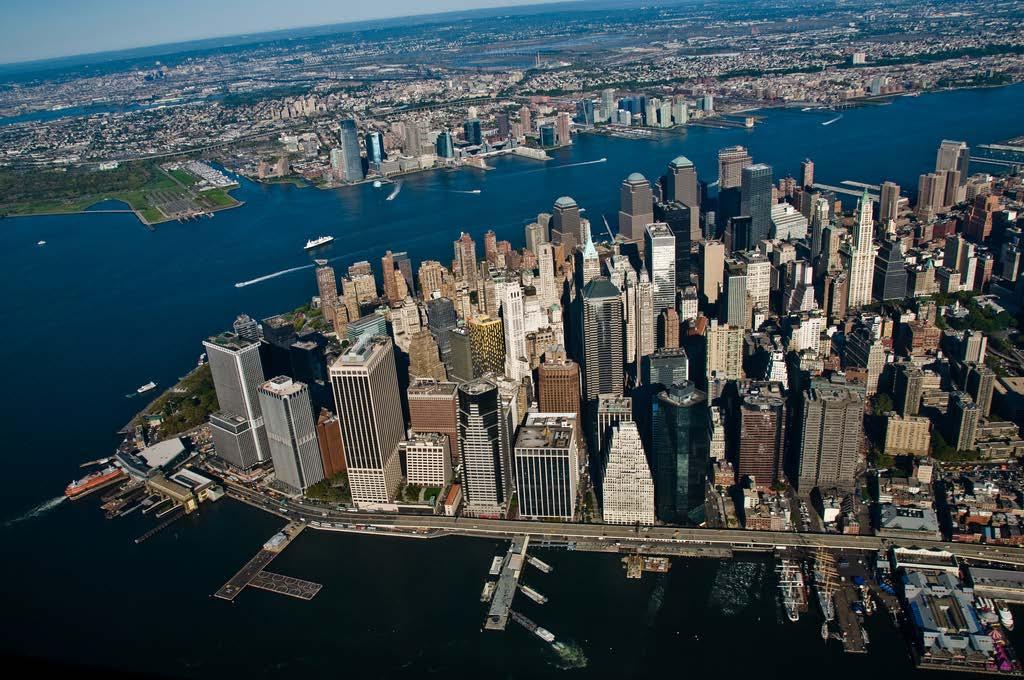
The seeds of the Lower Manhattan’s evolution and future are being sown by the district’s response to Hurricane Sandy. Signs of preparation for the future are visible everywhere.
Verizon’s investments to upgrade its Broad Street switching station and to replace its copper infrastructure with fiber-optic cable have fortified Lower Manhattan’s data and telecom ser vice against future flooding. Verizon is moving key equipment at its substations above ground, out of flood-prone areas, and fiber-optic cables are unaffected by flooding. The fiber-optic upgrades will not only harden current infrastructure but will also give Lower Manhattan the nation’s most advanced data and telecom network, a boon to the future growth of the district’s key industries—professional services, financial services, tech nology, and media.
While this work was being done, some tenants used the op portunity to switch to another service provider, such as Time Warner Cable Business Solutions. This leaves the district less reliant on a single service provider, making Lower Manhattan better positioned in the face of future recovery efforts.
Private property owners throughout Lower Manhattan not only quickly made their buildings ready for the return of tenants, they also made significant investments to enhance buildings’ ability to endure spending hundreds of millions of dollars on aggressive measures to make their buildings less susceptible to future flooding and storm damage. These extensive efforts include raising essential infrastructure above flood-prone areas and fortifying below-grade spaces housing fuel pumps.
Research and outreach conducted by the Downtown Alliance found at least 14 properties representing some 14 million square feet of Lower Manhattan office space undertaking such work. Though expensive in terms of capital outlay, forgone revenue from reduced rentable square footage, and diminished value from lost FAR (floor area ratio), these multi-million dollar investments, often without the aid of insurance, are all bullish signs for the district’s future.
Long-term investment in Lower Manhattan will soon visibly reshape its retail, residential and hospitality sectors. Not only are almost all of Lower Manhattan’s hotel rooms back open and filled to their normal capacities, six hotel projects are presently under construction adding 1,100 new rooms by 2014. Residen tial development continues undeterred: 1,300 units are pres ently under construction another four projects that have been publically announced could bring another 1,000 units to Lower Manhattan in the near future.
The retail sector is set to dramatically expand over the next several years with 200,000 square feet of stores at a renewed Seaport; another 200,000 square feet Brookfield Place; 350,000 square feet at Westfield World Trade; and 65,000 square feet at Fulton Center. Fulton Center, set to open in 2014, will be a landmark, transformative transportation hub accelerating the district’s position as a regional magnet for talent.
As a result of confronting this crisis, property owners, all levels of government, utilities and industry sectors have not only responded with rigor and lengthened foresight but they have recommitted and reinvested in Lower Manhattan’s future with a new emphasis on endurance, resiliency and transformation. Lower Manhattan is most definitely back in business.
13
ENDNOTES
Jones Lang Salle
Source of leasing activity and transactions: CBRE
Source of vacancy rate: Cushman & Wakefield
National Weather Service: www.hpc.ncep.noaa.gov/tropical/tropical_advisories.php?storm=SANDY&adnum=37&dt=2012103109 &status=remnants
Source of record water level: CNN, www.cnn.com/2012/10/30/us/sandy-records
Con Edison
Benchmarks on restoration of service provided by Verizon
Con Edison, Downtown Alliance
Verizon
Source of leasing activity and transactions: CBRE
Source of vacancy: Citi Habitats
Source of data on rents, and volume pf sales: Miller Samuel/Prudential Douglas Elliman
2012 tourism estimate: Audience Research and Analysis
Source of ADR and occupancy rates: Smith Travel Research, Inc. Republication or other re-use of this data without the express written permission of STR is strictly prohibited. Geographic definitions are custom sets for the Alliance for Downtown New York.
Source of ridership data: Metropolitan Transportation Authority
New York State Department of Labor
2012 tourism estimate: Audience Research and Analysis
ADDITIONAL SOURCES OF INFORMATION:
In addition to specific data points, the Downtown Alliance thanks the following organizations for contributing information to this report:
• Jones Lang LaSalle for contributing information on the restoration of commercial office stock
• Cushman & Wakefield for contributing information on retail transactions
• Verizon for contributing information on the restoration and improvements to Lower Manhattan’s data and telecommunications network
• Con Edison for contributing information on the restoration of power and steam
• Metropolitan Transit Authority for contributing information on the restoration of the subway system
• Fried, Frank, Harris, Shriver & Jacobson for contributing information on the firm’s experience following the storm
ADDITIONAL SOURCES OF INFORMATION:
Page 3: New York Magazine cover, photograph by Iwan Baan, courtesy of New York Magazine
Page 3: Source: New York City Office of Emergency Managment
14
I.
II.
III.
IV.
V.
VI.
VII.
VIII.
IX.
X.
XI.
XII.
XIII.
XIV.
XV.
XVI.
XVII.
Board of Directors Hon. Michael Bloomberg | David J. Arena | Peter Braus | Harry Bridgwood Mark E. Brooks | Hon. Margaret S. Chin | Betty Cohen | John V. Connorton, Jr. Charles C. Dorego | K. Thomas Elghanayan | David Fowler | Rachelle Friedman Stephen Friedman | Timur Galen | Robert J. Giuffra Jr. | Stanley E. Grayson Francis J. Greenburger | John Halvey | Hon. Catherine McVay Hughes | Thomas Hughes Richard T. Kennedy | Stephen Lefkowitz | Janno Lieber | Hon. John C. Liu Canon Anne Mallonee | Ross F. Moskowitz | Cherrie Nanninga | Dr. Antonio Perez Peter Poulakakos | Mitchell Rudin | William C. Rudin | Frank Sciame | Alan Scott Michael Skidmore | Allan Sperling | Hon. Scott Stringer | Kent M. Swig Philippe Visser | Hon. Robert W. Walsh
Robert R. Douglass, Chairman | Elizabeth H. Berger, President
Contributing Staff
Nicole LaRusso, Senior Vice President, Planning and Economic Development
Stephanie Jennings, Vice President, Economic Development
Alison Baumann, Research Analyst
Nicole Kolinsky, Director, Public Affairs Bathsheba Parker, Graphic Designer
Jeff Simmons, Communications Consultant
Andy Breslau, Vice President of Communications & Marketing


















